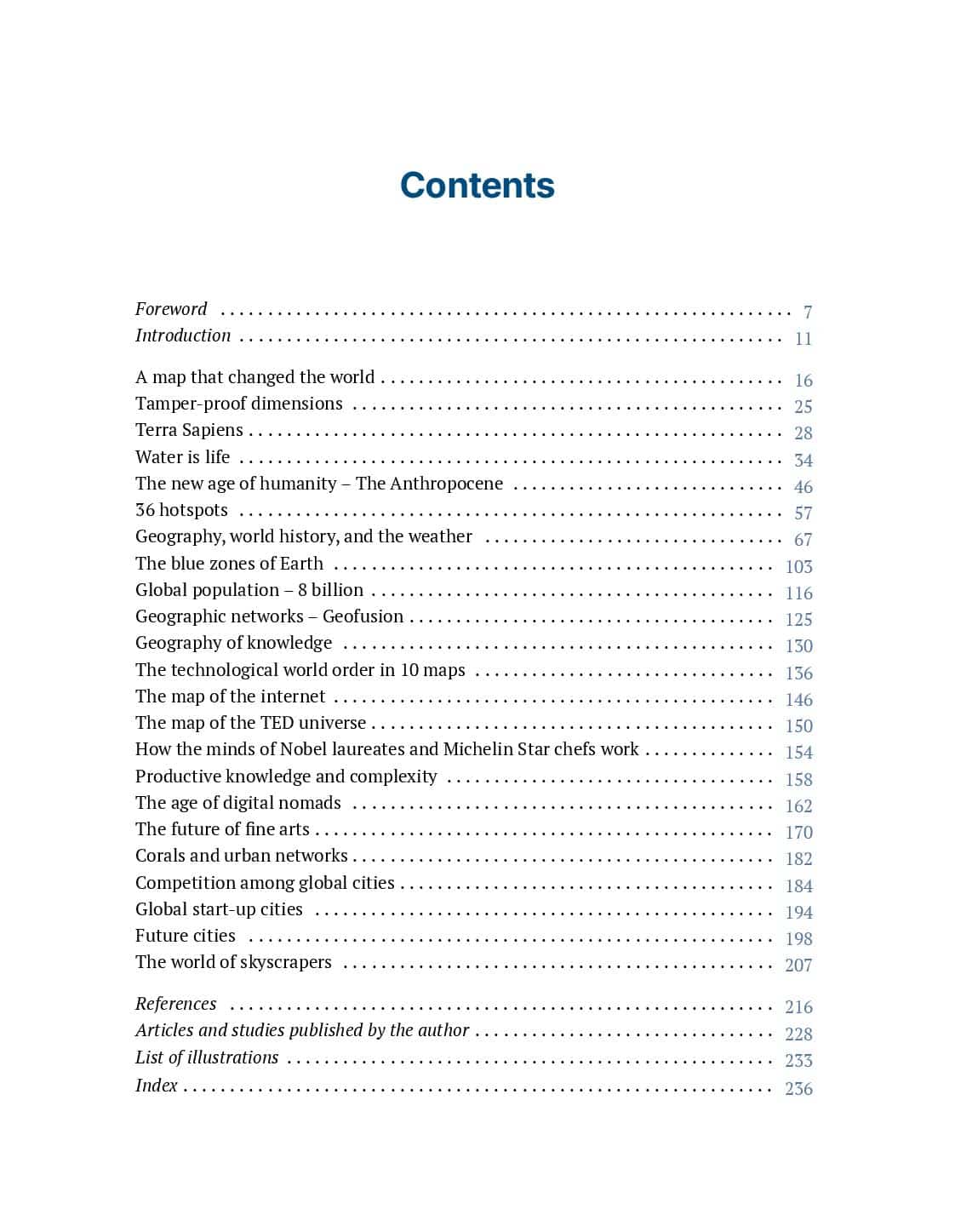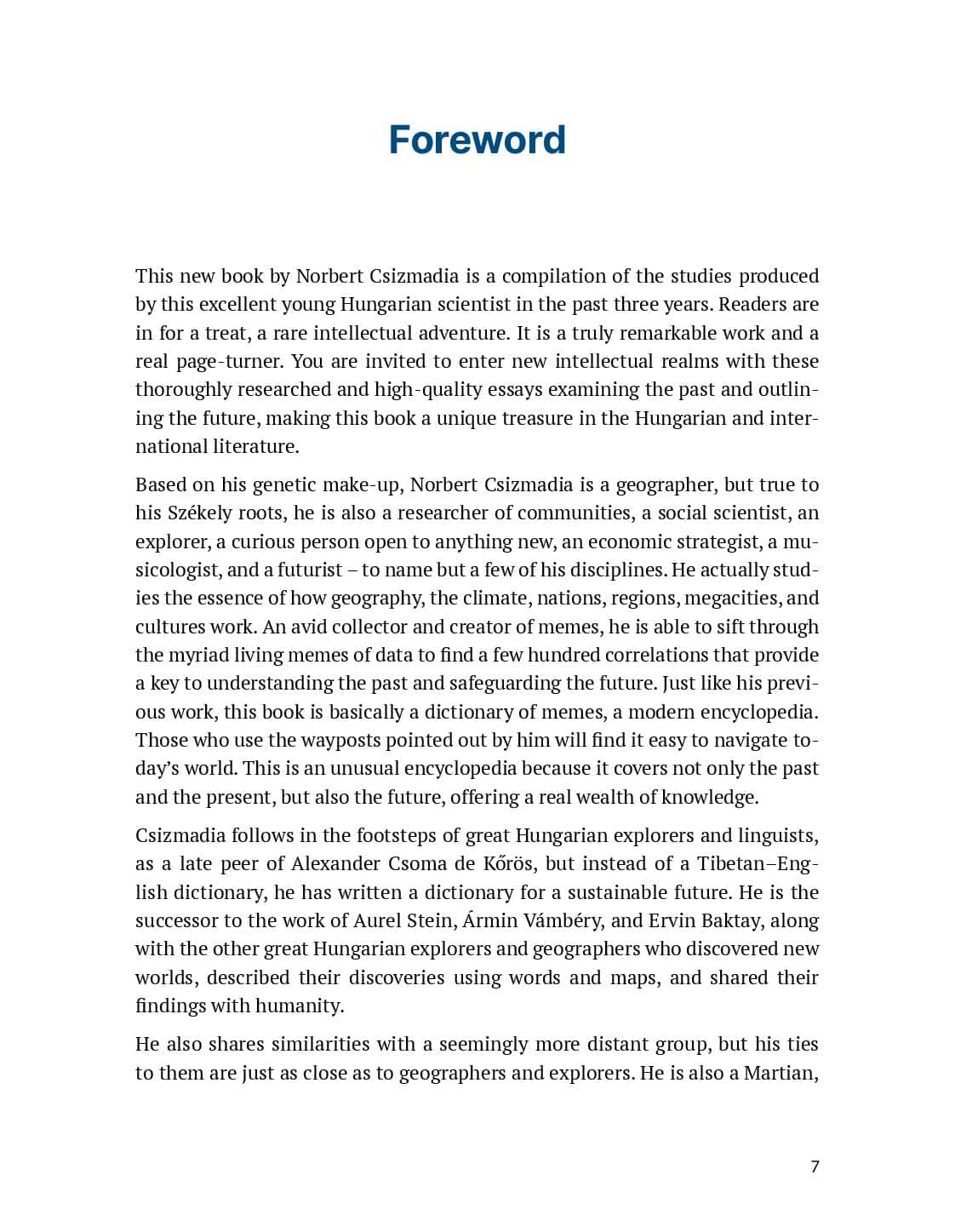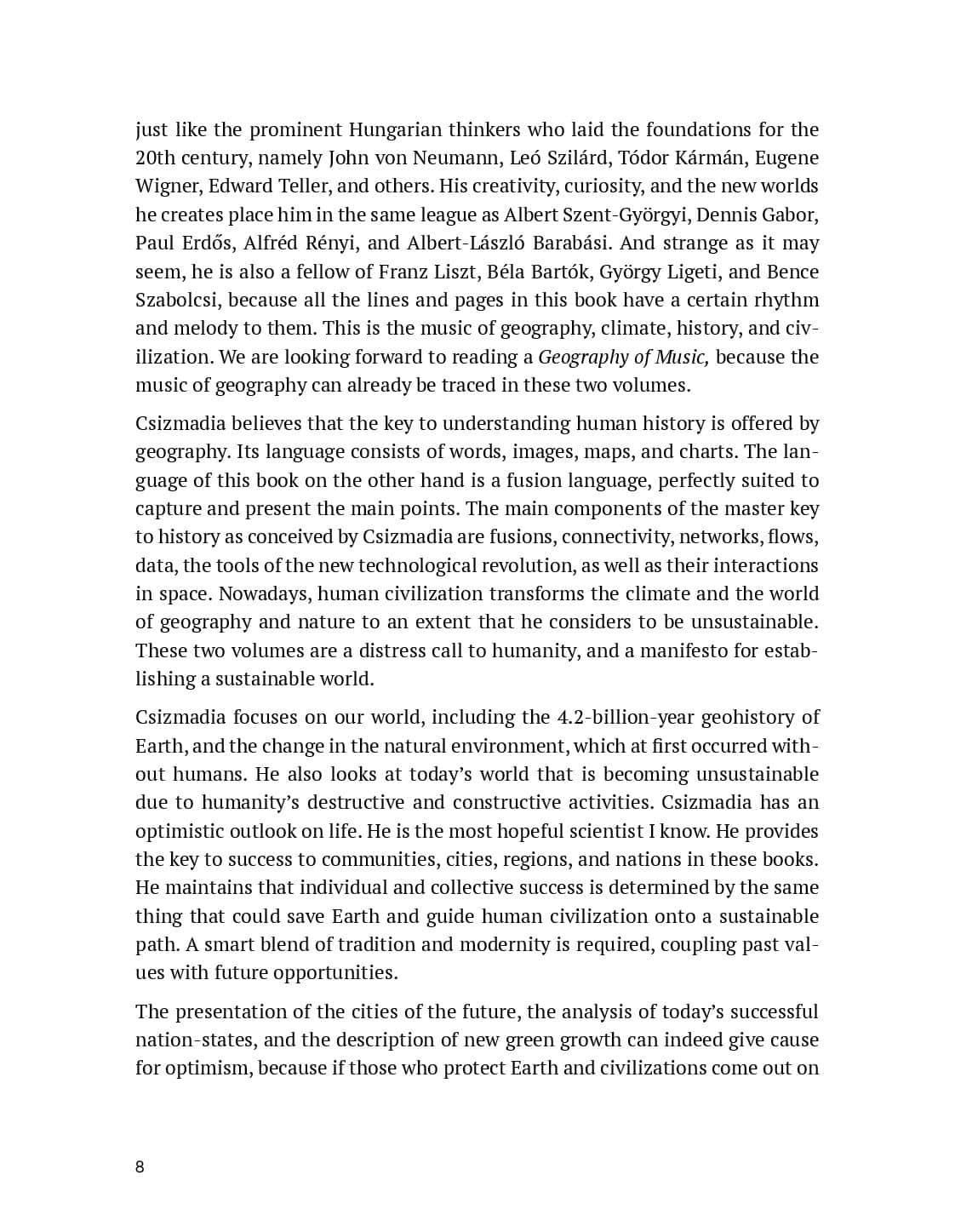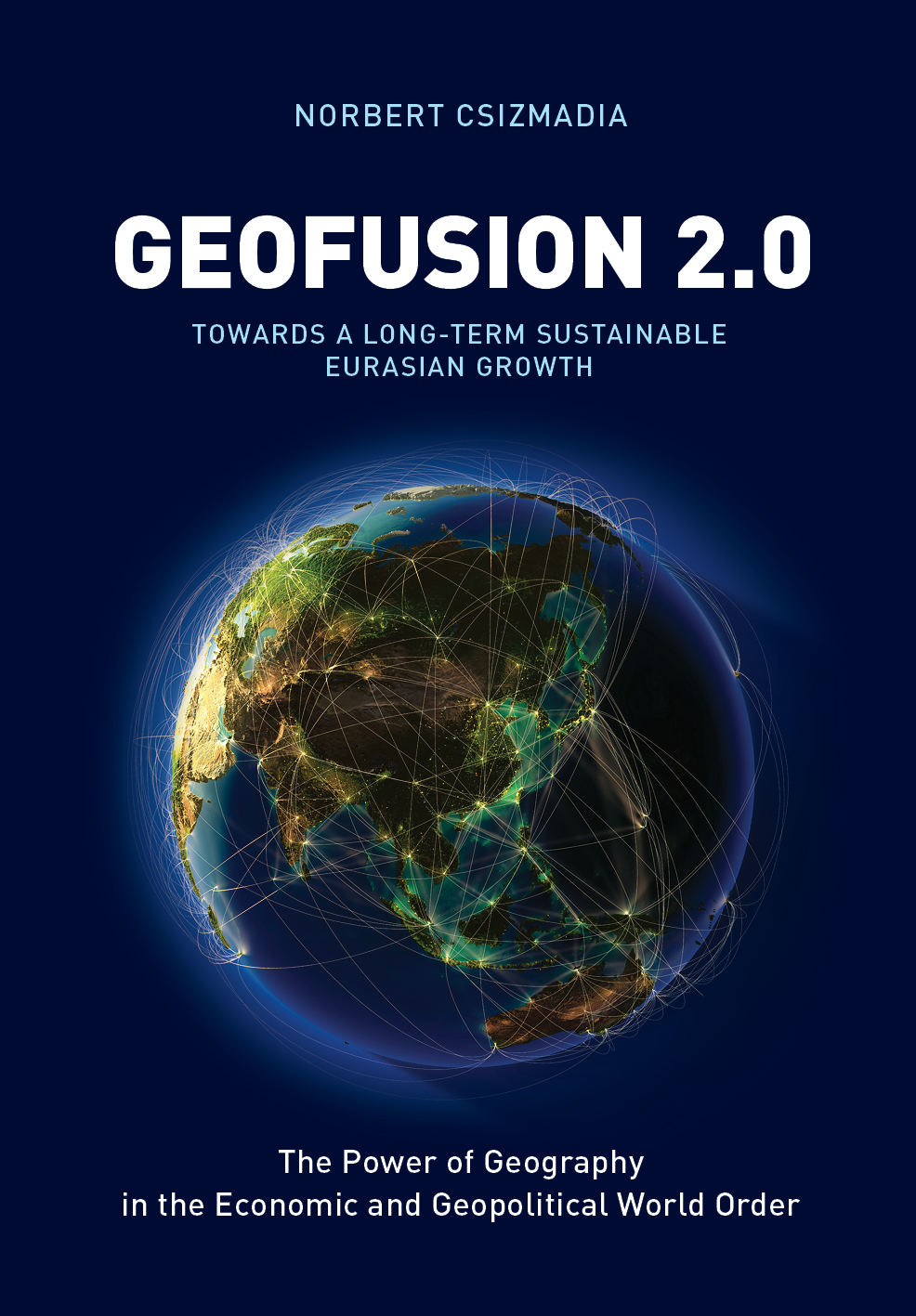Geovision I-II.
Sustainability and Eurasia
Original price was: 13 499 Ft.9 999 FtCurrent price is: 9 999 Ft.
The two volumes of Geovision use a geographer’s perspective while seeking to find answers to questions such as: Why is it important to understand the world through geography? What is geographical equilibrium? What are the fusions and networks of the age that we live in? Where are the most important hubs? How has humanity shaped the planet? Why does the growth of global cities resemble the growth of corals? Which are today’s most innovative countries, and why are they clustered around the same axis? What are the three main passwords of our age? What is meant by the rise of the East? What does a comprehensive and sustainable Eurasian world order look like, and why is it life-centered? How do the minds of Nobel laureates work? And what about Michelin Star chefs? What is technology-driven art? What do our usual maps look like when they are presented in a whole new way? To understand the developments around us, we need to turn to geography.
Geography returns and it is becoming more important. One only needs to think of today’s geopolitical challenges: the COVID-19 pandemic, the geographical and economic realignment in the world, the energy crisis, climate change, and sustainability issues. There is more to geography than simply memorizing places on maps. It is an important tool for getting to know the world. If we can read maps, we can understand one of the most beautiful and interesting visual languages we have.
Geovision is a geographical guidebook for curious explorers by Csizmadia Norbert
Tartalomjegyzék
Volume I.
Foreword . . . . . . . . . . . . . . . . . . . . . . . . . . . . . . . . . . . . . . . . . . . . . . . . . . . . . . . . . . . . 7
Introduction . . . . . . . . . . . . . . . . . . . . . . . . . . . . . . . . . . . . . . . . . . . . . . . . . . . . . . . . . 11
A map that changed the world . . . . . . . . . . . . . . . . . . . . . . . . . . . . . . . . . . . . . . . . . 16
Tamper-proof dimensions . . . . . . . . . . . . . . . . . . . . . . . . . . . . . . . . . . . . . . . .. . . 25
Terra Sapiens . . . . . . . . . . . . . . . . . . . . . . . . . . . . . . . . . . . . . . . . . . . . . . . . . . . . . . .28
Water is life . . . . . . . . . . . . . . . . . . . . . . . . . . . . . . . . . . . . . . . . . . . . . . . . . . . . . . . . 34
The new age of humanity – The Anthropocene . . . . . . . . . . . . . . . . . . . . . . . . . 46
36 hotspots . . . . . . . . . . . . . . . . . . . . . . . . . . . . . . . . . . . . . . . . . . . . . . . . . . . . . . . . . 57
Geography, world history, and the weather . . . . . . . . . . . . . . . . . . . . . . . . . . . . . 67
The blue zones of Earth . . . . . . . . . . . . . . . . . . . . . . . . . . . . . . . . . . . . . . . . . . . . . . 103
Global population – 8 billion . . . . . . . . . . . . . . . . . . . . . . . . . . . . . . . . . . . . . . . . . . 116
Geographic networks – Geofusion . . . . . . . . . . . . . . . . . . . . . . . . . . . . . . . . . . . . 125
Geography of knowledge . . . . . . . . . . . . . . . . . . . . . . . . . . . . . . . . . . . . . . . . . . . . . 130
The technological world order in 10 maps . . . . . . . . . . . . . . . . . . . . . . . . . . . . . . . 136
The map of the internet . . . . . . . . . . . . . . . . . . . . . . . . . . . . . . . . . . . . . . . . . . . . . .146
The map of the TED universe . . . . . . . . . . . . . . . . . . . . . . . . . . . . . . . . . . . . . . . . . 150
How the minds of Nobel laureates and Michelin Star chefs work . . . . . . . . . . 154
Productive knowledge and complexity . . . . . . . . . . . . . . . . . . . . . . . . . . . . . . . . . 158
The age of digital nomads . . . . . . . . . . . . . . . . . . . . . . . . . . . . . . . . . . . . . . . . . . . 162
The future of fine arts . . . . . . . . . . . . . . . . . . . . . . . . . . . . . . . . . . . . . . . . . . . . . . 170
Corals and urban networks . . . . . . . . . . . . . . . . . . . . . . . . . . . . . . . . . . . . . . . . . . . 182
Competition among global cities . . . . . . . . . . . . . . . . . . . . . . . . . . . . . . . . . . . . . . 184
Global start-up cities . . . . . . . . . . . . . . . . . . . . . . . . . . . . . . . . . . . . . . . . . . . . . . . 194
Future cities . . . . . . . . . . . . . . . . . . . . . . . . . . . . . . . . . . . . . . . . . . . . . . . . . . . . . . 198
The world of skyscrapers . . . . . . . . . . . . . . . . . . . . . . . . . . . . . . . . . . . . . . . . . . . . 207
References . . . . . . . . . . . . . . . . . . . . . . . . . . . . . . . . . . . . . . . . . . . . . . . . . . . . . . . . 216
Articles and studies published by the author . . . . . . . . . . . . . . . . . . . . . . . . . . . 228
List of illustrations . . . . . . . . . . . . . . . . . . . . . . . . . . . . . . . . . . . . . . . . . . . . . . . . . .233
Index . . . . . . . . . . . . . . . . . . . . . . . . . . . . . . . . . . . . . . . . . . . . . . . . . . . . . . . . . . . . . 236
Volume II.
The significance of geography in the multipolar
world order of the 21st century . . . . . . . . . . . . . . . . . . . . . . . . . . . . . . . . . . . . . . 7
21 theses for the 21st century . . . . . . . . . . . . . . . . . . . . . . . . . . . . . . . . . . . . . 16
21 maps for the 21st century . . . . . . . . . . . . . . . . . . . . . . . . . . . . . . . . . . . . . . 22
The world map from a new vantage point . . . . . . . . . . . . . . . . . . . . . . . . . . . 46
The world divided into 30 regions . . . . . . . . . . . . . . . . . . . . . . . . . . . . . . . . . . 52
The GDP map of the world in 2021 . . . . . . . . . . . . . . . . . . . . . . . . . . . . . . . . . 56
The world economy’s shifting center of gravity . . . . . . . . . . . . . . . . . . . . . . . 62
The changing spatial structure of the world economy . . . . . . . . . . . . . . . . . . 68
The geographical Achilles heels of global trade . . . . . . . . . . . . . . . . . . . . . . . 77
Small countries are the most innovative . . . . . . . . . . . . . . . . . . . . . . . . . . . . 86
South Korea . . . . . . . . . . . . . . . . . . . . . . . . . . . . . . . . . . . . . . . . . . . . . . . . . . . . 89
Israel . . . . . . . . . . . . . . . . . . . . . . . . . . . . . . . . . . . . . . . . . . . . . . . . . . . . . . . . 117
Singapore in 36 points . . . . . . . . . . . . . . . . . . . . . . . . . . . . . . . . . . . . . . . . . . 127
The rise of China . . . . . . . . . . . . . . . . . . . . . . . . . . . . . . . . . . . . . . . . . . . . . . . 137
Chengdu: China’s creative and cultural capital . . . . . . . . . . . . . . . . . . . . . . 159
Shanghai: China’s global hub . . . . . . . . . . . . . . . . . . . . . . . . . . . . . . . . . . . . 169
Shenzhen: China’s Silicon Valley . . . . . . . . . . . . . . . . . . . . . . . . . . . . . . . . . . 177
KIDSzingChi.hu: Eastern examples of sustainable convergence . . . . . . . . 185
The prosperity of the future . . . . . . . . . . . . . . . . . . . . . . . . . . . . . . . . . . . . . . 205
Special Hungarian IMAGE-anation . . . . . . . . . . . . . . . . . . . . . . . . . . . . . . . . 210
Hungarians at the vanguard of vehicle manufacturing . . . . . . . . . . . . . . . . 216
Hungarian achievements in IT . . . . . . . . . . . . . . . . . . . . . . . . . . . . . . . . . . . . 223
64 books to accompany Geovision . . . . . . . . . . . . . . . . . . . . . . . . . . . . . . . . . 228
List of illustrations . . . . . . . . . . . . . . . . . . . . . . . . . . . . . . . . . . . . . . . . . . . . . 232
Index . . . . . . . . . . . . . . . . . . . . . . . . . . . . . . . . . . . . . . . . . . . . . . . . . . . . . . . . 235
További információk
| Tömeg | 2,108 kg |
|---|---|
| Méretek | 22,5 × 15,2 × 8 cm |
| Szerző | Csizmadia Norbert |
| Borító | Keménytábla,cérnafűzőtt,védőborító |
| Fordító | Gáspár Bence |
| ISBN | 978-963-573-214-2 |
| Megjelenés ideje | 2023-11-21 |
| Oldalszám | 480 |
| Eredeti magyar cím | Geovízió I-II. |


















